Abstract
The ability of various pseudomonads to utilize acyclic isoprenoids as a sole carbon source was investigated. Tests for utilization of acyclic isoprenols such as citronellol and geraniol were complicated by toxic effects of these alcohols, and most species tested were killed by exposure to citronellol or geraniol (0.1%, vol/vol) in liquid culture. In the case of Pseudomonas citronellolis, sensitivity to isoprenols is reduced by prior induction of the isoprenoid degradative pathway via either growth on succinate in the presence of citronellol or growth on citronellic acid. For this species, citronellic acid proved to be the best isoprenoid growth substrate tested. Geraniol utilization as a taxonomic indicator for different subgroups of pseudomonads is discussed. Only a few of the species tested were able to utilize acyclic isoprenoids. Two species which utilize C10 acyclic isoprenoids, P. aeruginosa and P. mendocina, were shown to contain the inducible enzyme geranyl-coenzyme A carboxylase, one of the unique enzymes in the isoprenol degradative pathway known to occur in P. citronellolis. Of the species which utilized geranitol, none showed definite growth on the homologous C15 and C20 isoprenols.
Full text
PDF
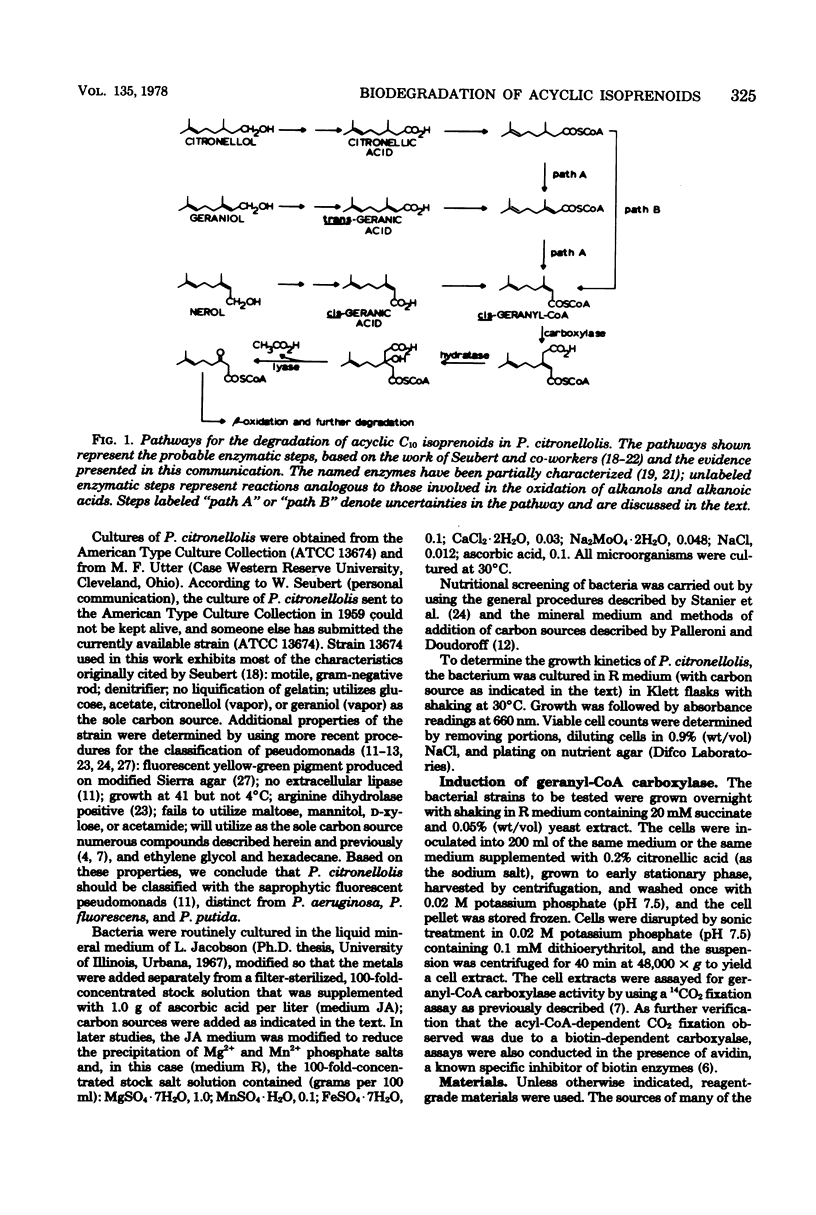
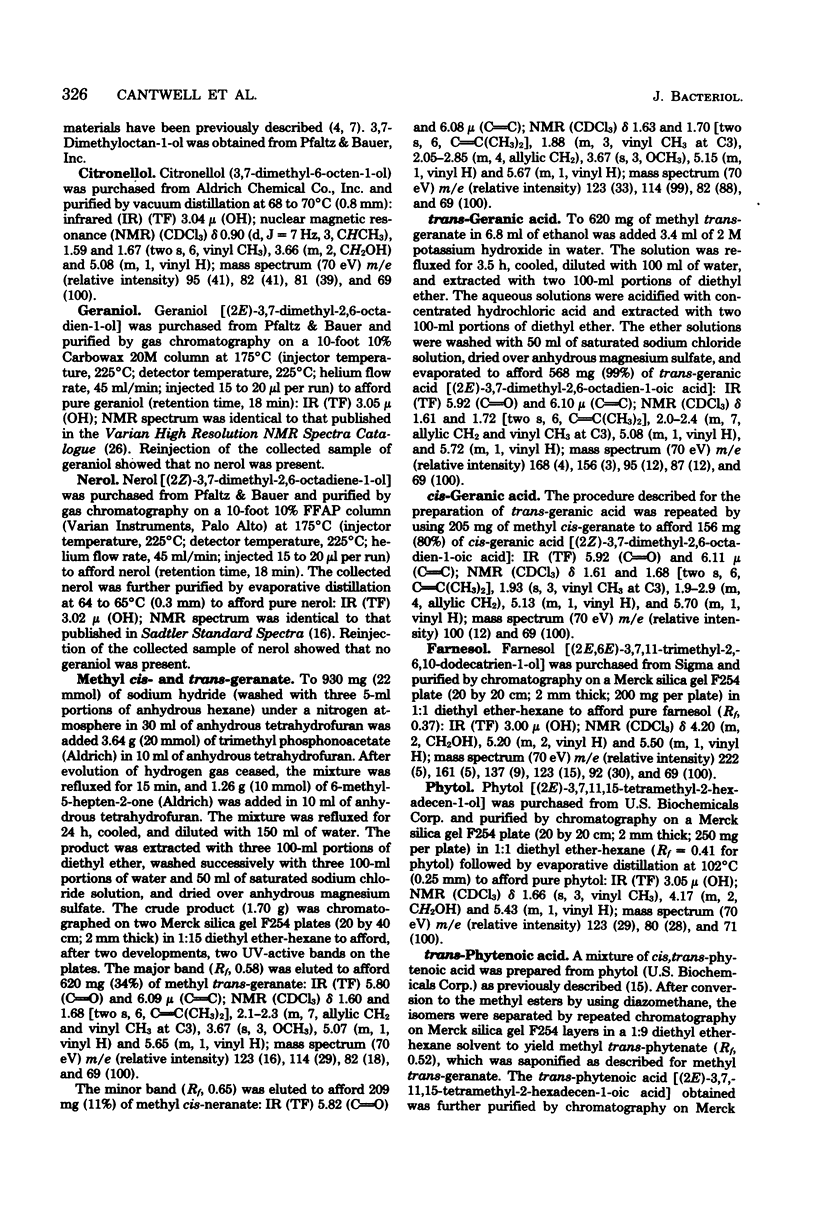
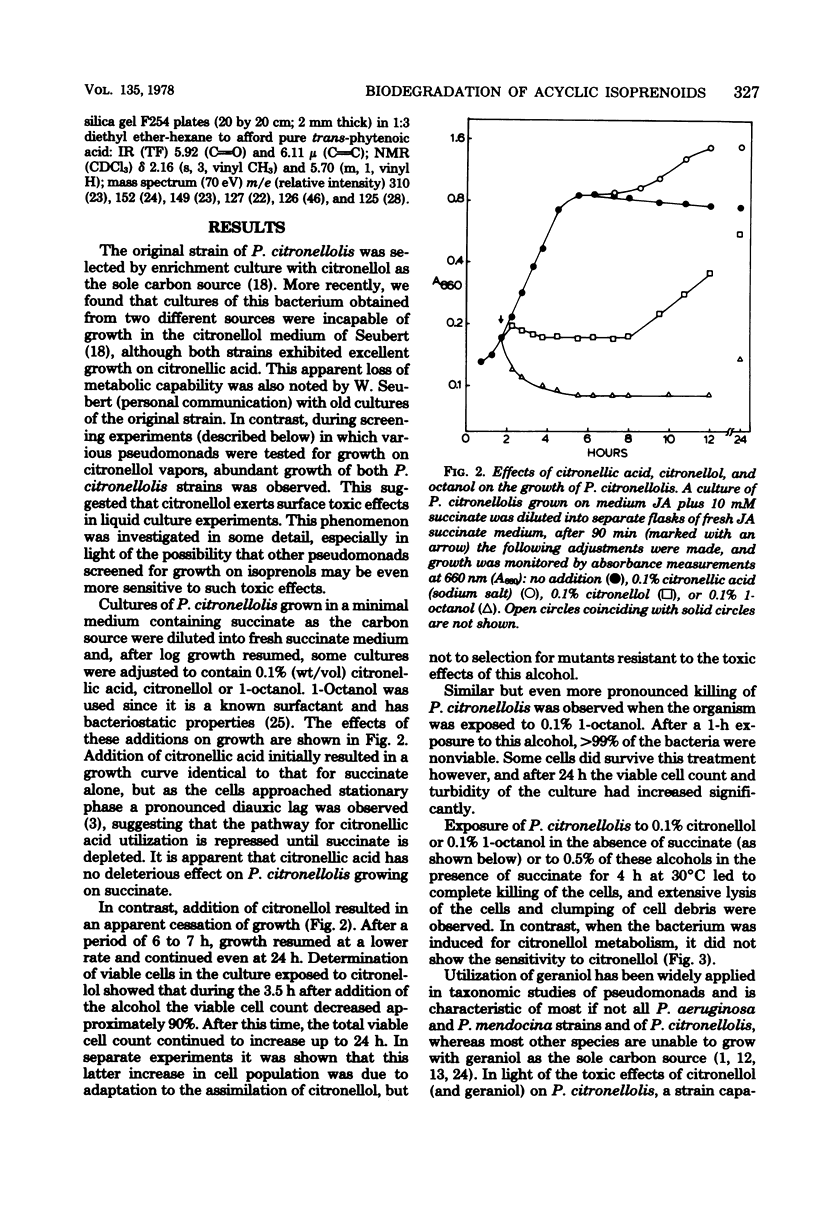
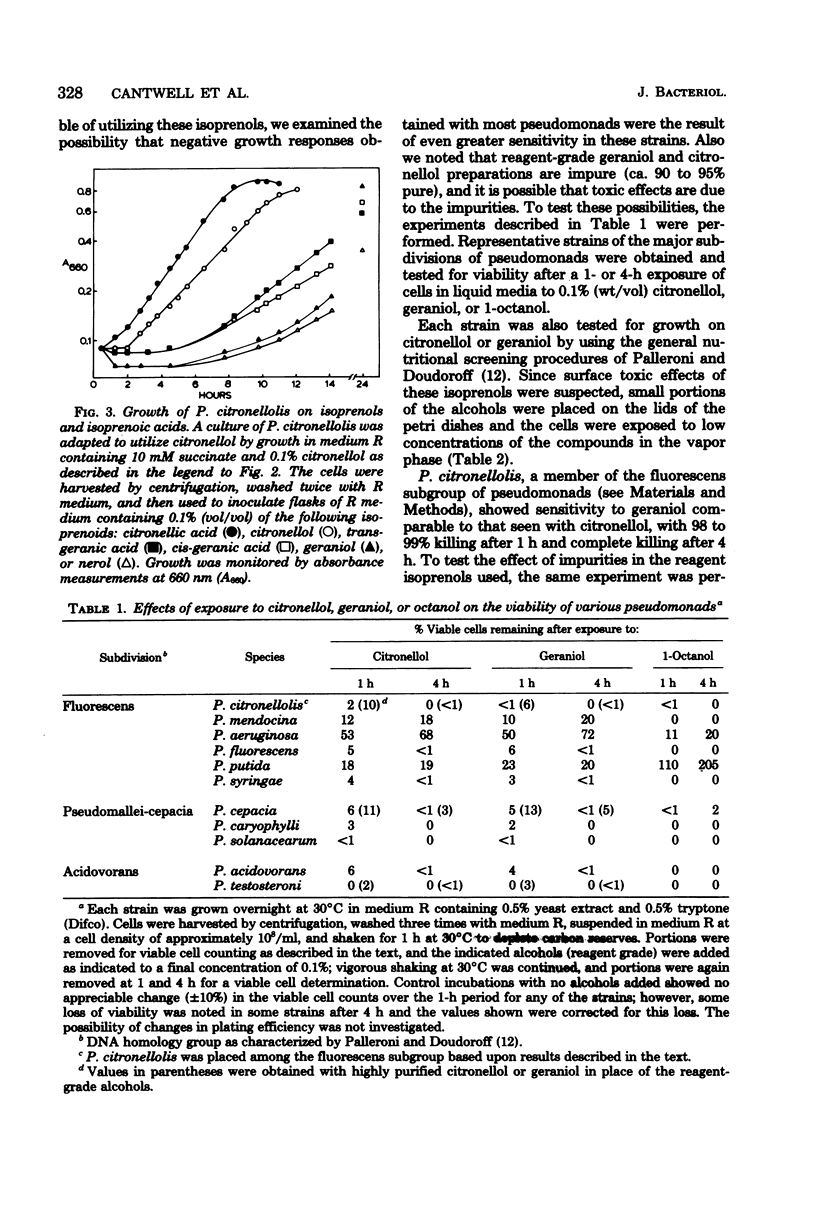
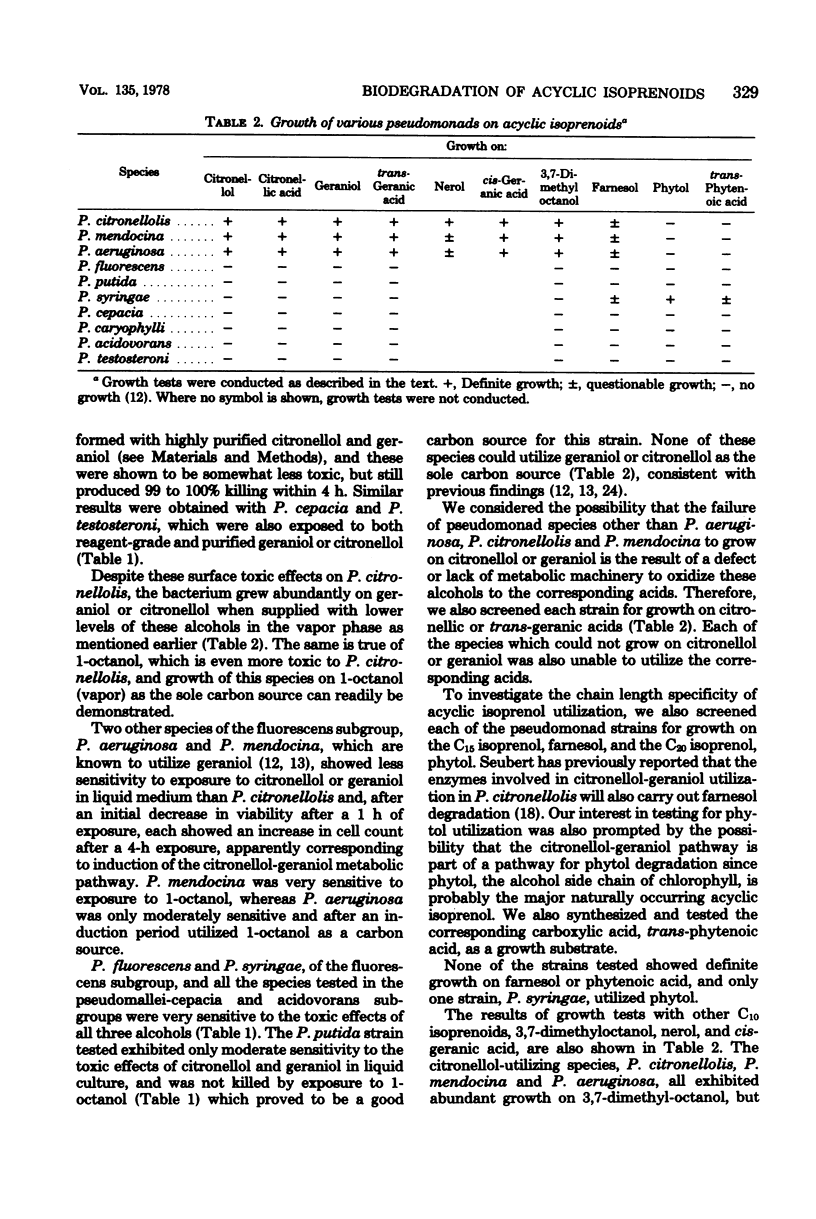


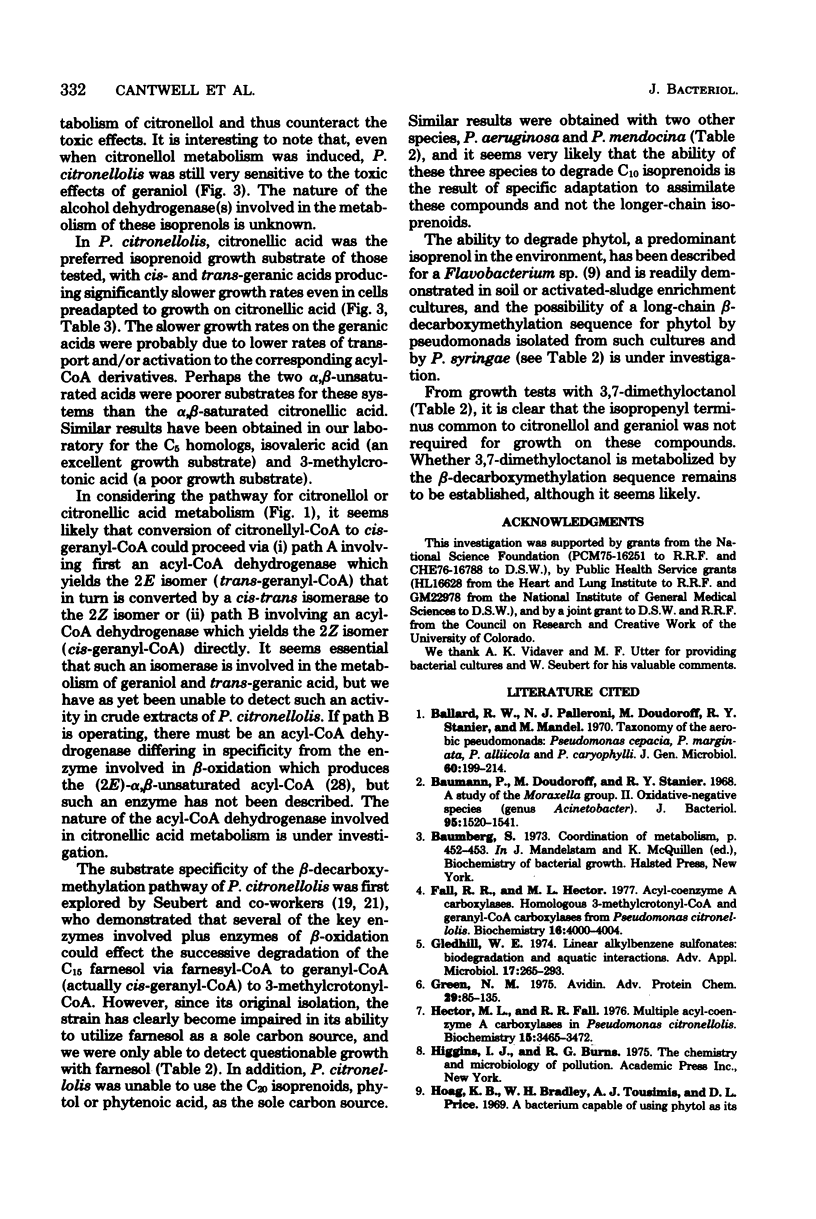

Selected References
These references are in PubMed. This may not be the complete list of references from this article.
- Ballard R. W., Palleroni N. J., Doudoroff M., Stanier R. Y., Mandel M. Taxonomy of the aerobic pseudomonads: Pseudomonas cepacia, P. marginata, P. alliicola and P. caryophylli. J Gen Microbiol. 1970 Feb;60(2):199–214. doi: 10.1099/00221287-60-2-199. [DOI] [PubMed] [Google Scholar]
- Baumann P., Doudoroff M., Stanier R. Y. A study of the Moraxella group. II. Oxidative-negative species (genus Acinetobacter). J Bacteriol. 1968 May;95(5):1520–1541. doi: 10.1128/jb.95.5.1520-1541.1968. [DOI] [PMC free article] [PubMed] [Google Scholar]
- Fall R. R., Hector M. L. Acyl-coenzyme A carboxylases. Homologous 3-methylcrotonyl-CoA and geranyl-CoA carboxylases from Pseudomonas citronellolis. Biochemistry. 1977 Sep 6;16(18):4000–4005. doi: 10.1021/bi00637a010. [DOI] [PubMed] [Google Scholar]
- Gledhill W. E. Linear alkylbenzene sulfonate: biodegradation and aquatic interactions. Adv Appl Microbiol. 1974;17(0):265–293. doi: 10.1016/s0065-2164(08)70561-6. [DOI] [PubMed] [Google Scholar]
- Green N. M. Avidin. Adv Protein Chem. 1975;29:85–133. doi: 10.1016/s0065-3233(08)60411-8. [DOI] [PubMed] [Google Scholar]
- Hector M. L., Fall R. R. Multiple acyl-coenzyme A carboxylases in Pseudomonas citronellolis. Biochemistry. 1976 Aug 10;15(16):3465–3472. doi: 10.1021/bi00661a011. [DOI] [PubMed] [Google Scholar]
- Misaghi I., Grogan R. G. Nutritional and biochemical comparisons of plant-pathogenic and saprophytic fluorescent pseudomonads. Phytopathology. 1969 Oct;59(10):1436–1450. [PubMed] [Google Scholar]
- Palleroni N. J., Doudoroff M., Stanier R. Y., Solánes R. E., Mandel M. Taxonomy of the aerobic pseudomonads: the properties of the Pseudomonas stutzeri group. J Gen Microbiol. 1970 Feb;60(2):215–231. doi: 10.1099/00221287-60-2-215. [DOI] [PubMed] [Google Scholar]
- SEUBERT W. Degradation of isoprenoid compounds by micro-organisms. I. Isolation and characterization of an isoprenoid-degrading bacterium, Pseudomonas citronellolis n. sp. J Bacteriol. 1960 Mar;79:426–434. doi: 10.1128/jb.79.3.426-434.1960. [DOI] [PMC free article] [PubMed] [Google Scholar]
- SEUBERT W., FASS E., REMBERGER U. UNTERSUCHUNGEN UEBER DEN BAKTERIELLEN ABBAU VON ISOPRENOIDEN. III. REINIGUNG UND EIGENSCHAFTEN DER GERANYLCARBOXYLASE. Biochem Z. 1963;338:265–275. [PubMed] [Google Scholar]
- SEUBERT W., FASS E. UNTERSUCHUNGEN UEBER DEN BAKTERIELLEN ABBAU VON ISOPRENOIDEN. V. DER MECHANISMUS DES ISOPRENOIDABBAUES. Biochem Z. 1964 Dec 7;341:35–44. [PubMed] [Google Scholar]
- SEUBERT W., REMBERGER U. UNTERSUCHUNGEN UEBER DEN BAKTERIELLEN ABBAU VON ISOPRENOIDEN. II. DIE ROLLE DER KOHLENSAEURE. Biochem Z. 1963;338:245–264. [PubMed] [Google Scholar]
- Schiele U., Niedermeier R., Stürzer M., Lynen F. Investigations of the structure of 3-methylcrotonyl-CoA carboxylase from Achromobacter. Eur J Biochem. 1975 Dec 1;60(1):259–266. doi: 10.1111/j.1432-1033.1975.tb20998.x. [DOI] [PubMed] [Google Scholar]
- Sneath P. H., Collins V. G. A study in test reproducibility between laboratories: report of a Pseudomonas Working Party. Antonie Van Leeuwenhoek. 1974;40(4):481–527. doi: 10.1007/BF00403815. [DOI] [PubMed] [Google Scholar]
- Stanier R. Y., Palleroni N. J., Doudoroff M. The aerobic pseudomonads: a taxonomic study. J Gen Microbiol. 1966 May;43(2):159–271. doi: 10.1099/00221287-43-2-159. [DOI] [PubMed] [Google Scholar]
- WAHBA A. H., DARRELL J. H. THE IDENTIFICATION OF ATYPICAL STRAINS OF PSEUDOMONAS AERUGINOSA. J Gen Microbiol. 1965 Mar;38:329–342. doi: 10.1099/00221287-38-3-329. [DOI] [PubMed] [Google Scholar]


